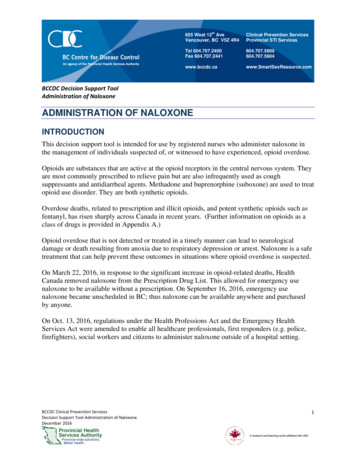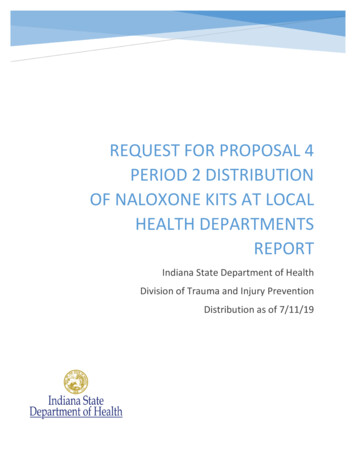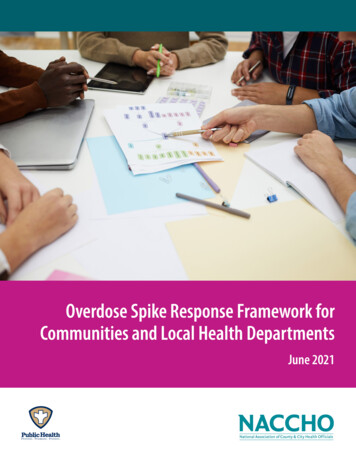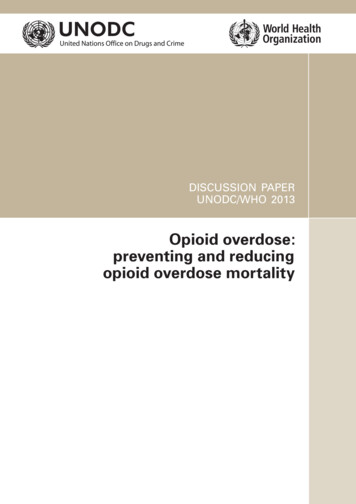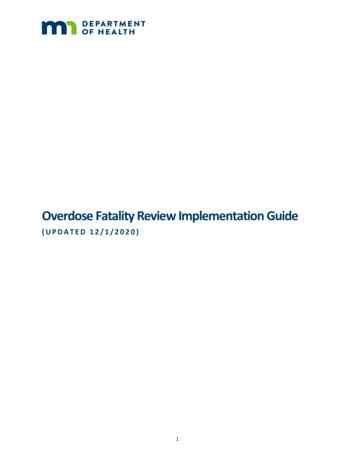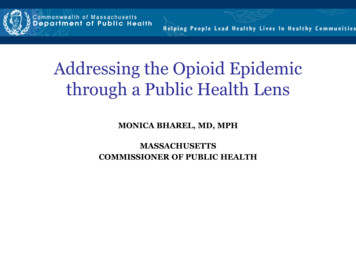
Transcription
Implementation of Overdose Education and NaloxoneDistribution in Criminal Justice Settings:The NEXT StudyLynn Wenger1, David Showalter1,2, Barrot Lambdin1, ElizaWheeler3, Ingrid Binswanger4 and Alex Kral111th Academic & Health Policy Conference on Correctional HealthMarch 22nd – 23rd , 2018 Houston, TX1RTIInternational, 2 University of California, Berkeley, 3 Harm Reduction Coalition,4 Kaiser Permanente Colorado, Institute for Health ResearchNIDA Grant #5R34DA039101-03RTI International is a registered trademark and a trade name of Research Triangle Institute.www.rti.org
Overview The opioid overdose epidemic Describe Overdose Education and Naloxone Distribution (OEND) in thecommunity as well as in CJ Settings. Present preliminary findings from our NIDA funded, ImplementationScience study of OEND in Criminal Justice Settings (P.I. Alex H Kral)
The Opioid Overdose Epidemic
Opioid overdose deaths in the US 2000-2016
Community based OverdoseEducation and Naloxone Distribution(OEND)
Naloxone prevents fatal overdose Naloxone, is an opioid antagonistNaloxone attaches to the opioid receptors in the brain, kicking opioidsoff of the receptors, reversing slow heart rate and respiratorydepressionThere are no physical side effects associated with naloxoneadministration except those associated with withdrawalLaypeople, including PWIDs and other community members, have beentrained and administering Naloxone more than 20 years.Laws in almost every state across the US allow naloxone to bedistributed under a physicians standing orderWith those laws in place, providers and laypeople have immunity fromcriminal and civil liability when prescribing, possessing or administeringnaloxone
Types of NaloxoneInjectableNasal SprayAuto-injector
Community based OEND programs From 1996- 2015, 644programs in the U.S. trained152,283 laypersons1The programs that collectreversal data documented26,463 overdose reversals1Studies show thatcommunities with OENDprograms have lower fataloverdose rates thancommunities without OENDprograms212Wheeler, E. et al. (2015). Opioid overdose prevention programsproviding naloxone to laypersons -United States, 2014. MMWR64(23), 631-635.Walley, A.Y. et al. (2013). Opioid overdose rates andimplementation of overdose education and nasal naloxonedistribution in Massachusetts: interrupted time series analysis.BMJ 346, f174
OEND in Criminal Justice settings
Overdose risk at re-entry–Formerly incarcerated people had 129times the risk of overdose death duringthe 2 weeks immediately followingrelease from prison than the generalpopulation.3– And the risk remains elevated up to atleast the 4th week post release.4– Individuals released from jail, also havesignificantly higher rates of drug relateddeaths within the 2 weeks afterrelease.53BinswangerI.A., et al. (2007). Release from prison—a high risk of death for former inmates. NEJM356(2), 157-165;E.L.C, et. al. (2010). Meta-analysis of drug-related deaths soon after release from prison. Addiction 105pp.1545-1554/5Lim, S., et.al. (2012). Risks of drug-related death, suicide, and homicide during the immediate post-release period amongpeople released from New York City jails, 2001-2005 Am J. Epidemiology 175(6):519-52604 Merrall,
Why train people in OEND pre-release? Abstinence and infrequent use during incarceration lowersopioid tolerance, increasing risk of overdose in the event ofrelapseInadequate services to support integration into the communityLimited access to drug treatment, homelessness and lack ofsocial support following releaseThus, opioid relapse is common and risk for overdose is highafter release from prison or jailPeople exiting incarceration are released to communitiesheavily impacted by drug use and may witness an opioidrelated overdose. Possessing the knowledge about overdoseprevention and a naloxone kit could save lives.
Potential Venues for Naloxone Implementation for peopleexiting incarceration Training of inmates conducted in jail, naloxone in propertyIn visitors centerWithin probation departments or re-entry programsIn housing or substance abuse treatment programs specificallyfor people exiting incarceration
Existing OEND programs in CJ settings New York State, Baltimore, Chicago, Denver, Boulderand Arapahoe, CO, Seattle WA, Durham, NC;Pittsburgh & Philadelphia, PA , Cuyahoga CountyOH, and San Francisco have all implemented OENDprograms in criminal justice settings All programs use similar curriculum, procedures anddistribute similar naloxone kits. What differs is the population that is targeted toreceive the interventionIn this 3/21/2016, photograph, inmate Eric Burton examines analoxone dose while conferring with a doctor at the DenverCounty Jail in downtown Denver. (AP Photo/David Zalubowski)
The NEXT Study
The NEXT Study The goal of this research is to identify barriers and facilitators anddevelop solutions for the implementation of overdose preventionprograms in Criminal Justice settings Three San Francisco Bay Area counties. Interviews with key stakeholders in health care services,corrections, and re-entry programs. Implementation of OEND in two pilot venues – existingprograms targeting people exiting incarceration Development of a manual to address the key factors andlessons learned
Barriers Lack of Information and need for education– Insufficient overdose death data––– Service provision barriers––– Lack of basic knowledge about OEND programsMyths about naloxoneLack of information regarding legal issues related to distribution of NaloxoneCompeting priorities for providing services to people exiting jailBelief that drug users couldn’t possibly intervene and save livesLack of local harm reduction servicesInstitutional barriers––––––Budgetary constraints and staffingInstitutional fragmentation (larger counties)Insular nature of CJ settings, not easily influenced by other programsConservative settings where there is resistance to changeJail security proceduresJail health services provided by private company – not part of public health department
Facilitators Individuals and groups who are who are committed toOEND–––– Information and Education–––– Local champions who can cut trough red tapeDoctors who are willing to write a standing orderCounty level coalitions working towards overdose preventionSupport from local politiciansMedia coverage of the overdose epidemicProviding data related to risks of overdose and successes of OEND programmingBringing people together to discuss the risk of overdose for those exiting incarcerationAccess to expertsAvailable resources–––––Local, state and federal funds for overdose prevention, re-entry services and substance usetreatment are available & can be used to fund these programsExisting county-wide initiatives addressing opioid overdose preventionExisting partnerships within the county systems of care with procedures in place forcollaborationCBOs committed to the population and interested in building OEND servicesLocal programs with access to jails – with jail clearance and experience working in CJsettings (e.g., programs providing HIV/HCV testing in jail)
NEXT study successes
Implementation of OEND in Bay Area Counties To date OEND has been implemented in two of the three countieswe were working in – both continue to struggle with on-going barriersto service provision–A small jail has incorporated OEND into their substance use treatmentprogramming. They are providing training, but are still struggling with thejail for approval to place naloxone in the participants’ property.– A re-entry clinic has trained their behavioral health employees to providethe training and has begun training a limited number of patients. Theyreceived a limited supply of naloxone from the state of California andcannot expand the program without additional funding.
Discussion In light of the severity of the opioid overdose epidemic; bystanders,including people exiting incarceration, must be trained to administernaloxoneImplementation of OEND in CJ settings and training of inmates prerelease is an essential tool to reduce fatal overdoseBarriers to implementation include, lack of information as well asservice provision and institutional barriersHowever, utilizing staff as OEND trainers, who already providetesting in jail, who already have jail clearance and are familiar withthe population can facilitate implementation.Increased information and education, acquisition of resources andhaving players at the table who are committed to harm reduction andimproving the health of drug users facilitates implementation.
Thank you!
Overdose risk at re-entry -Formerly incarcerated people had 129 times the risk of overdose death during the 2 weeks immediately following release from prison than the general population.3 -And the risk remains elevated up to at least the 4th week post release.4 -Individuals released from jail, also have significantly higher rates of drug related

